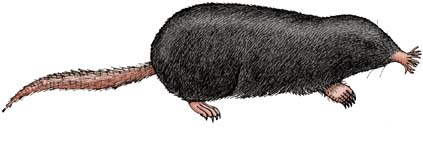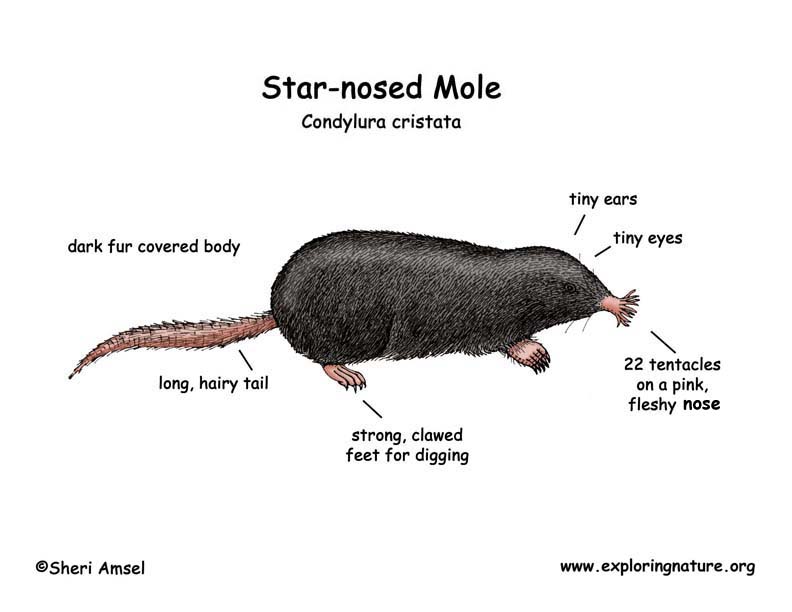

They are found in eastern Canada and the U.S. south to about Georgia and west to Manitoba and the Dakotas.
They live in habitats with moist soil. This can be in forests, wetlands, meadows or scrubby areas as long as poor drainage keeps the soil moist.
Star-nosed moles are about 4.5 inches long and are covered with dark fur except on their feet and snout. Their front feet are large and clawed for digging. The tail is up to 3.25 inches long (8.5 cm) and is scaly, ringed and covered in rough hairs.The tail is fatter in winter because the moles stores fat there that will give the mole energy for spring breeding. They have a ring of 22 tiny, fleshy tentacles (11 pairs), called rays, around the tip of the nose in a star pattern. Each ray has tiny sense organs called Elmer's organs. These sensitive rays are used to find food in the ground. They have small eyes and no visible ears (they do have ears though and very good hearing).
They dig shallow tunnels in the soil pushing out the excess soil to form molehills above ground. They can swim and may have tunnels that empty out underwater into a pond or wetland.
They eat earthworms, insects, spiders, small amphibians and fish.
They are eaten by hawks, owls, weasels, minks and fishers.
The females are pregnant for 6.5 weeks (gestation) and give birth to a litter of up to 7 tiny, hairless young in the spring. Pairs will are monogamous for the length of the breeding season.
They can live for up to 4 years in the wild, but usually less.
Kingdom: Animalia
Phylum: Chordata
Class: Mammalia
Order: Soricomorpha
Family: Talpidae
Subfamily: Scalopinae
Genus: Condylura
Species: C. cristata
When you research information you must cite the reference. Citing for websites is different from citing from books, magazines and periodicals. The style of citing shown here is from the MLA Style Citations (Modern Language Association).
When citing a WEBSITE the general format is as follows.
Author Last Name, First Name(s). "Title: Subtitle of Part of Web Page, if appropriate." Title: Subtitle: Section of Page if appropriate. Sponsoring/Publishing Agency, If Given. Additional significant descriptive information. Date of Electronic Publication or other Date, such as Last Updated. Day Month Year of access < URL >.
Amsel, Sheri. "Mole (Star-nosed)" Exploring Nature Educational Resource ©2005-2024. December 16, 2024
< http://www.exploringnature.org/db/view/497 >

